Lawn mower maintenance is essential if you want your lawn mower to consistently deliver optimal performance. The more you use your mower, the more crucial maintenance becomes. Understanding how to properly care for your lawn mower will extend its lifespan and ensure it cuts your grass as flawlessly as the day you bought it.
TOOLS & REQUIREMENTS
- Gloves
- Engine oil (for gas mowers)
- Spark plug (for gas mowers)
- Fuel filter (for gas mowers)
- Air filter (for gas mowers, optional for electric)
- New belt (if required)
- Tire pump (if needed)
- Socket wrench (for spark plug removal in gas mowers)
- Metal file (or blade sharpening tool)
Even the best gas lawn mowers and best electric lawn mowers won’t maintain their peak condition without regular upkeep. Maintenance encompasses a wide range of tasks, from simple cleaning and washing to prevent the build-up of dirt and debris, to more specific procedures like changing the oil in gas mowers, checking the battery in electric mowers, and sharpening the blades for both types.
Before you embark on our essential lawn mower maintenance guide, be sure to consult your manufacturer’s manual to identify the specific tools and parts you’ll need for your particular model.
QUICK STEPS: HOW TO MAINTAIN YOUR LAWN MOWER
- Change the oil
- Clean/replace the air filter
- Replace the spark plug (every 12 months)
- Clean and sharpen blades
- Stabilize the fuel
- Check the battery
- Check the fuel filter and replace (if needed)
- Check tire pressure
- Service the belts
- Clean the lawn mower
- Winterize the mower
STEP BY STEP GUIDE: HOW TO MAINTAIN YOUR LAWN MOWER
1. Change the oil
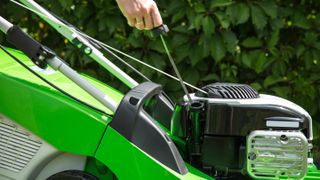
Turn on the engine briefly to warm up the oil, then turn it off and let the engine cool down. This will make the oil less viscous and easier to drain. Position a container to catch the used oil, remove the oil cap, and carefully tilt the lawn mower on its side, ensuring the oil flows into the container.
Once the oil has drained completely, return the mower to its upright position on all four wheels. Refer to your manufacturer’s manual to determine the correct type and amount of oil required for your specific model. Using a funnel, carefully pour the new oil into the engine and securely replace the oil cap.
2. Clean/replace the air filter
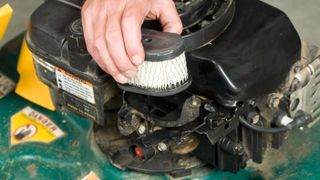
Why should you clean or replace your lawn mower’s air filter? As Ryan Patterson, Residential Segment Manager at Husqvarna, explains: “Regular air filter replacement is vital, especially in dusty environments. A compromised filter can hinder your mower’s starting ability and lead to a noticeable decrease in power during operation. Therefore, it’s recommended to replace the filter every 3 months or at least once per season, depending on usage.”
To access the air filter, locate and remove the air filter cover on your lawn mower. If your mower has a paper filter, gently tap it against a firm surface to dislodge any dust particles. For foam filters, remove and wash them in warm, soapy water. After squeezing out excess water, allow the filter to dry completely before reinstalling it. Ensure the filter is properly seated and secure. If you notice any damage, wear, or persistent dirtiness after cleaning, replace the air filter with a new one.
3. Replace the spark plug (every 12 months)

A dirty or damaged spark plug can significantly impact your lawn mower’s performance. Patterson recommends replacing it annually, stating, “Spark plugs are relatively inexpensive, and we advise replacing them every year or two.” You can find a variety of spark plugs for lawn mowers on Amazon.
To replace the spark plug, first disconnect the ignition cable. Then, using the appropriate size socket for your socket/torque wrench, place it onto the spark plug and carefully remove it. Take your new spark plug and screw it in by hand, followed by tightening it with the wrench to ensure a secure fit.
4. Clean and sharpen blades
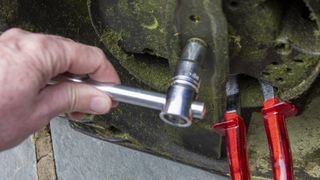
Ensure your mower is disconnected from its power source, either by unplugging it or removing the spark plug cap. Wipe down the blade with a cloth and warm, soapy water. To remove stubborn dirt and debris, use a kitchen scrubber or sponge. Once clean, wipe the blade dry.
For optimal sharpening, remove the blade from the mower. Most blades are secured with a central bolt, requiring a wrench and a pair of heavy-duty gloves for safety – such as the WZQH Leather Work Gloves available on Amazon.
Securely clamp the blade to a flat, sturdy surface or place it in a vice. Using a fine metal file, like one from the REXBETI 17Pcs Metal File Set available on Amazon, position it at the same angle as the blade edge and push down and forward. Repeat this process until the blade is sufficiently sharpened.
5. Stabilize the fuel
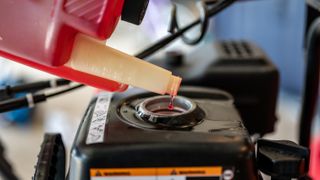
Stabilizing your lawn mower’s fuel offers numerous advantages, as Husqvarna’s Patterson explains: “Fuel stabilizer eliminates the need to drain fuel before storage by keeping it fresh for approximately two years, and it helps prevent buildup within the engine’s fuel system.”
To stabilize the fuel, simply follow the instructions on the stabilizer packaging and then run the engine for a few minutes to allow the solution to circulate throughout the fuel system. Essentially, you’re adding a solution to the fuel that helps prevent it from deteriorating during storage.
6. Check the battery
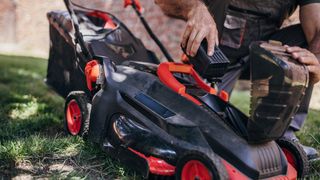
If your lawn mower is equipped with a battery, it’s important to verify it’s in good working condition. Keep in mind that most gas-powered walk-behind mowers don’t have batteries. Locate the battery and utilize a multimeter to confirm that the voltage matches the expected level.
For cordless mowers powered by a battery, find the battery and detach it from the mower. Most batteries feature a battery level indicator. Simply press and hold the button to view the remaining power. Recharge the battery if necessary.
7. Check the fuel filter and replace
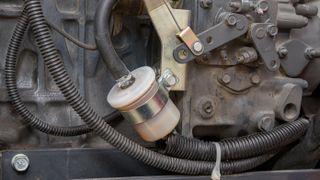
The fuel filter plays a crucial role in preventing dirt and debris from entering the carburetor and compromising your lawn mower’s performance. Consequently, it requires regular replacement. Patterson advises, “Depending on usage, an annual replacement of the fuel filter should be sufficient. Neglecting to change it can lead to poor engine performance and, eventually, render the mower unusable.”
Before you begin, ensure the power to the mower is disconnected. Locate the fuel filter and remove it. While there are various types of fuel filters, it’s generally best to replace them unless the manufacturer specifically recommends cleaning.
8. Check tire pressure
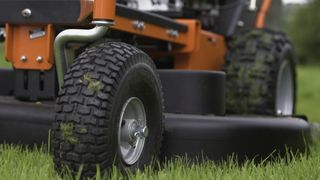
If your lawn mower doesn’t have solid wheels, it’s crucial to check the tire pressure. Patterson emphasizes the importance of this, stating, “It’s vital to check tire pressure and ensure it’s consistent across all tires.”
He further explains, “Uneven tire pressure can lead to an uneven and inconsistent cut.” If you don’t already own one, consider investing in a pressure gauge, such as the AstroAI ATG250 Digital Tire Pressure Gauge available on Amazon. Consult your mower’s manual for the recommended tire pressure levels.
9. Service the belts
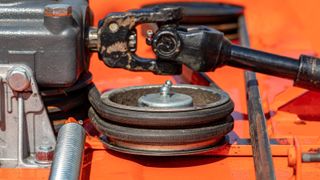
Lawn mower belts play a crucial role in connecting the engine to the blade and require proper attention. As Patterson from Husqvarna explains, “Mower belts should be inspected regularly. There isn’t a set timeframe for replacing them, as their lifespan depends on operating conditions. It’s essential to ensure the belts are not worn or damaged and are properly tensioned.”
However, installing lawn mower belts can be challenging and varies from model to model. Refer to your manufacturer’s manual for specific instructions. If you’re unsure, consider visiting a local dealer to have the job done professionally.
10. Clean the lawn mower
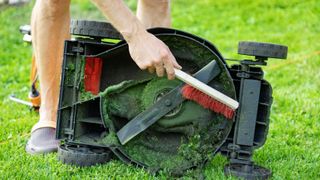
Ideally, cleaning your lawn mower after each use is recommended. A quick brush with a stiff brush followed by a wash with water and a cloth, or using a garden hose, will suffice. Always ensure the power source is disconnected before cleaning. Neglecting to clean after each use can lead to the accumulation of grass and dirt on the mower’s interior and blade, hindering its performance.
If there’s a buildup of dirt and grass, dampen the affected area and let it sit for five minutes before using a plastic scraper like the Cotarba Durable Plastic Scraper Set available on Amazon. Avoid using sharp edges, as they can damage the mower. Finally, apply a spray of WD-40 to protect and lubricate the components.
11. Get ready for mowing season

If you followed our guide on how to store your lawn mower for winter, your mower should be primed and ready for action when spring arrives. Simply remove the cover, brush off any accumulated dust, and quickly assess if any of the aforementioned maintenance steps are needed before you start mowing for the season.
Electric mowers will likely require a battery recharge, while gas mowers may need a top-up of oil and gasoline.
Wondering when to start mowing your lawn in the spring? Our comprehensive article delves into the optimal timing based on your location and grass type, ensuring your lawn stays healthy and vibrant throughout the growing season.
HOW TO MAINTAIN YOUR LAWN MOWER: FAQS
How often should a lawn mower be serviced?
The frequency of servicing your lawn mower depends on how often you use it. However, as a general rule for home use, an annual service should suffice, according to Ryan Patterson, Residential Segment Manager at Husqvarna.
He elaborates, “For standard use, petrol lawn mowers should be serviced at least every 12 months. However, if used more frequently, we recommend servicing blades every 25-30 hours of use, changing oil every 30 hours or so, and inspecting all other moving parts every 50 hours. Battery lawn mowers should also receive an annual service and follow a similar maintenance schedule.”
Should I wash my lawn mower after every use?
It may seem tedious, but maintaining a clean lawn mower is crucial for ensuring optimal performance. Allowing dirt and grass to accumulate can negatively impact its efficiency. Patterson emphasizes the importance of cleanliness, stating, “Make sure you clean your lawn mower after every use and always double-check that it’s clean before you start using it again.”
How often should I oil my lawn mower?
Regularly check your lawn mower’s oil by removing the dipstick, wiping it clean, and checking the current level. If it’s low, simply add more oil to reach the appropriate level. However, remember that the oil will need to be changed eventually.
As Ryan Patterson, Residential Segment Manager at Husqvarna, advises: “Change the oil either after every 25 hours of operation or at the end of each season. In particularly dusty or dirty conditions, more frequent oil changes may be necessary.”
Where to buy spare lawn mower parts
If you need to replace parts on your lawn mower, your first resource should be the manufacturer’s website to see if they offer official parts or have authorized suppliers. For instance, if you own a Husqvarna lawn mower, you can visit their website and utilize the store locator to find a nearby service center.
You can also explore online options, visiting specialized lawn mower websites like Lawn Mower Parts World or MTD to search for suitable parts. Your local Home Depot might carry the necessary components, and Amazon is another reliable source offering a wide range of lawn mower parts.
FINAL THOUGHTS
Properly maintaining your lawn mower is crucial for ensuring its longevity and optimal performance. Neglecting regular upkeep can lead to decreased efficiency and a shortened lifespan.
By incorporating a few simple steps into your routine throughout the mowing season, along with the essential annual maintenance outlined in the steps above, you can ensure your lawn mower remains a reliable companion for years to come.



